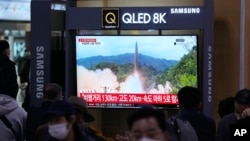North Korea’s recent tests of its Hwasong-17 intercontinental ballistic missile (ICBM) appear to be aimed at developing a missile with multiple nuclear warheads that can target the United States, experts said.
North Korea conducted several ICBM-related tests this year, the majority involving the Hwasong-17, the new “monster” missile believed to be the largest road-mobile ICBM in the world. Pyongyang unveiled the missile at a nighttime parade on October 10, 2020.
North Korea test-fired a barrage of missiles in the past week and said on Monday the launches were a “corresponding military operation” aimed at conducting simulated strikes on South Korea and the U.S. in response to large-scale allied air drills.
Among the missiles launched last week was a Hwasong-17 ICBM fired from Pyongyang’s Sunan District on November 2. South Korea’s Joint Chiefs of Staff said this test reached about 1,920 kilometers in altitude and flew 760 kilometers in distance.
Multiple nuclear warheads
Experts said North Korea is trying to develop the Hwasong-17 to ensure the delivery of a bigger payload — potentially one capable of carrying multiple nuclear warheads to cause greater destruction anywhere in the U.S. — than earlier ICBMs, the Hwasong-14 and Hwasong-15.
Bruce Bennett, a senior defense analyst at the RAND Corporation, said Pyongyang is developing a bigger missile for two reasons – to “reach anywhere in the U.S. with a real North Korean-sized nuclear weapon,” which is estimated to be approximately 500 kilograms or more, and to cause a “more intimidating threat against the United States” with multiple warheads.
He added the size of the nuclear warhead could significantly reduce the distance a missile could travel.
The Hwasong-14 has a maximum range of about 10,000 kilometers, and the Hwasong-15 has a range of up to 13,000 kilometers. The Hwasong-17 reportedly has a maximum range of at least 15,000 kilometers.
Ankit Panda, a senior fellow of the Nuclear Policy Program at the Carnegie Endowment for International Peace, said the Hwasong-17 “is possibly a test-bed for advanced payload technologies, including possibly a post-boost vehicle that would be a necessary component for any sophisticated multiple warhead payload.”
A post-boost vehicle also called a “bus” refers to a ballistic missile payload containing multiple independently targetable warheads (MIRVs) that can each be guided to strike different targets. This makes interception difficult.
Hans Kristensen, director of the Nuclear Information Project at the Federation of American Scientists, said, “Because of its size, the Hwasong-17 could potentially (if and when they fix the problems, and it becomes operational, and they demonstrate a functioning ICBM reentry vehicle) carry one or several large warheads.”
Failed test
The Hwasong-17 ICBM, however, is still considered at an early stage of development.
A Hwasong-17 test-fired on November 2 failed after separating at the second stage, according to the Joint Chiefs in Seoul, falling into the East Sea before completing a full flight.
North Korea did not mention the failed ICBM test in a statement released on Monday.
The last time North Korea successfully conducted a full flight test of the Hwasong-17 was on March 24. The missile reached 6,248 kilometers in altitude and 1,090 kilometers in distance, according to North Korea at the time. South Korea, however, said the missile tested on March 24 was a variant of the Hwasong-15 rather than the Hwasong-17.
'Reliability problems'
Experts said the failed test last week suggests North Korea doesn't yet have a reliable Hwasong-17 that can make a full flight.
“There’s clearly reliability problems likely due to issues with manufacturing, faulty components or quality control,” said Ian Williams, deputy director of the Center for Strategic and International Studies.
“I don’t think this is an indication there’s anything systemically wrong with North Korea’s ICBM program. It’s just reliability problems,” he said.
He added Pyongyang has reliable Hwasong-14 and Hwasong-15 ICBMs. Both were successfully tested in 2017. The Hwasong-14 can hit the West Coast of the U.S., and the Hwasong-15 can reach anywhere in the U.S. including the East Coast.
Experts said an engine ignition problem in the second stage may have caused the Hwasong-17 to fail last week.
A set of engines used to thrust the missile into the space breaks off after the fuel is burned during the first stage, referred to as the boost phase.
Then the second set of engines ignite during what is generally called the mid-course phase, until the second tank of fuel is exhausted.
The second-stage engines fall off and the remaining top part or payload that would contain a nuclear warhead continues to travel through the space until it drops down and reenters the atmosphere and strikes the target.
Bruce Bechtol, a former intelligence officer at the U.S. Defense Intelligence Agency and now a professor at Angelo University in Texas, said, “Unlike the Hwasong-14 and Hwasong-15, which the North Koreans could probably fire up [to aim at] the United States tomorrow, it appears a Hwasong-17 is a long way from being operational.”







